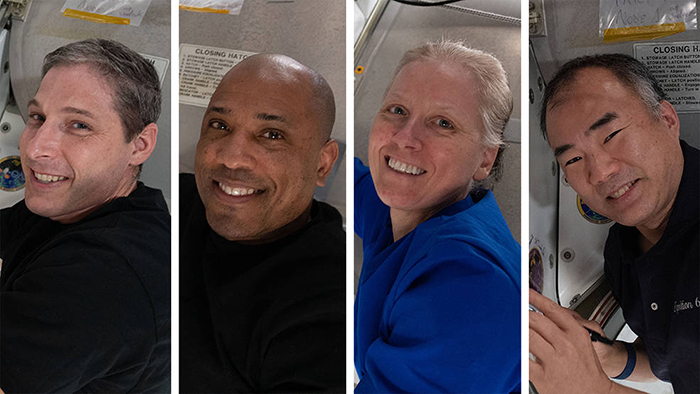| |
See live coverage of NASA’s SpaceX Crew-1 return to earth
May 1, 2021

Pictured from left are Expedition 64 Flight Engineers and SpaceX Crew-1 members Michael Hopkins, Victor Glover, Shannon Walker and Soichi Noguchi. Credits: NASA |
NASA’s SpaceX Crew-1 mission with NASA astronauts Michael Hopkins, Victor Glover, and Shannon Walker, and Soichi Noguchi of the Japan Aerospace Exploration Agency (JAXA) is now targeting a return to Earth no earlier than about 2:57 a.m. EDT Sunday, May 2, in the Gulf of Mexico off the coast of Florida. The Crew Dragon spacecraft, named Resilience, is scheduled to undock from the International Space Station at 8:35 p.m. Saturday, May 1, to begin the journey home.
NASA and SpaceX decided to move Crew-1’s undocking and splashdown from Friday, April 30, and Saturday, May 1, respectively, following a review of the forecast weather conditions in the splashdown zones off the coast of Florida, which predicted wind speeds above the return criteria. Crew Dragon is in great health on the space station, and teams now forecast ideal conditions for both splashdown and recovery during the weekend.
The return to Earth – and activities leading up to the return – will air live on NASA Television, the NASA App, and the agency’s website.
This will be the first night splashdown of a U.S. crewed spacecraft since Apollo 8’s predawn return in the Pacific Ocean on Dec. 27, 1968, with NASA astronauts Frank Borman, Jim Lovell and Bill Anders.
Crew-1 is the first of six crewed missions NASA and SpaceX will fly as part of the agency’s Commercial Crew Program, which worked with the U.S. aerospace industry to return launches with astronauts on American rockets and spacecraft from American soil.
The Crew Dragon will undock autonomously and depart from the space station with the capability to splashdown at one of seven targeted landing zones in the Atlantic Ocean or Gulf of Mexico off the coast of Florida. Resilience also will return to Earth important and time-sensitive research. The NASA and SpaceX teams select a primary and alternate splashdown location from the seven possible landing locations about two days prior to return, factoring in weather, crew rescue, and recovery operations. Additional decision milestones take place prior to undocking, during free flight, and before Crew Dragon performs the deorbit burn.
NASA and SpaceX closely coordinate with the U.S. Coast Guard to establish a 10-nautical-mile safety zone around the expected splashdown location to ensure safety for the public and for those involved in the recovery operations, as well as the crew aboard the returning spacecraft.
NASA’s SpaceX Crew-1 return coverage is as follows (all times are Eastern):
Saturday, May 1
6 p.m. – NASA TV coverage begins for 6:20 p.m. hatch closure
8:15 p.m. – NASA TV coverage begins for 8:35 p.m. undocking
Sunday, May 2
2:57 a.m. (approx.) – Splashdown (NASA TV will provide continuous coverage from undocking to splashdown)
NASA’s Commercial Crew Program has delivered on its goal of safe, reliable, and cost-effective transportation to and from the International Space Station from the United States through a partnership with American private industry. This partnership is changing the arc of human spaceflight history by opening access to low-Earth orbit and the International Space Station to more people, more science, and more commercial opportunities. The space station remains the springboard to NASA's next great leap in space exploration, including future missions to the Moon and, eventually, to Mars.
Learn more about space station activities by following @space_station, and @ISS_Research on Twitter, as well as the ISS Facebook and ISS Instagram accounts and the space station blog.
Learn more about splashdown locations, weather criteria, and recovery logistics.
See full mission coverage, NASA's commercial crew blog, and more information about the mission at:
www.nasa.gov/commercialcrew
|

